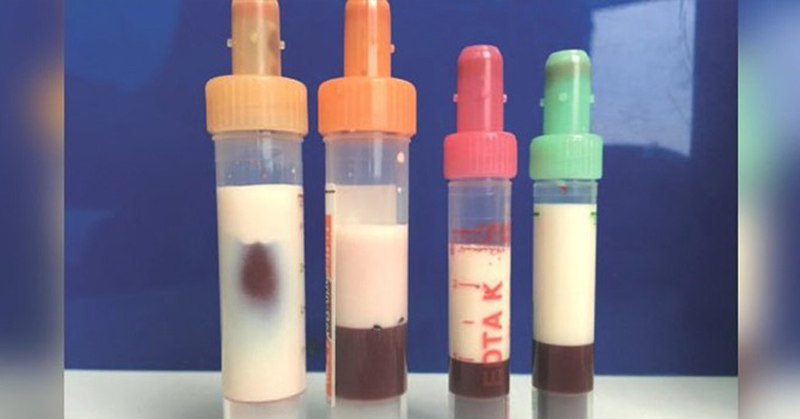When you hear the term “bloodletting” you probably see images of terrifying medical procedures from the eighteenth century flash through your mind that you’ve only seen in history books and museums.
Bloodletting, once one of the most common operative procedures in ancient medicine, is mostly regarded these days as an extinct form of pseudoscience that caused more harm than good [1].Doctors in Germany, however, recently found a use for this bygone practice when presented with a patient suffering from extreme hypertriglyceridemia [2].
High-Fat Blood
Hypertriglyceridemia is a condition wherein you have high levels of fatty triglyceride molecules in your blood [3]. It puts you at greater risk for cardiovascular disease, and is associated with obesity, metabolic syndrome, proinflammatory and prothrombotic biomarkers, and type 2 diabetes mellitus [3].
In this case in Germany, the patient in question had so much fat in his blood that looked like milk [2].
Normal Protocol Was Not Enough
Ordinarily in cases like this, doctors would use a treatment called therapeutic plasmapheresis, which can be an effective and rapid treatment for patients with severe hypertriglyceridemia (HTG) [4].
Plasmapheresis is a procedure in which the liquid part of your blood (the plasma) is separated from your blood cells, and is either replaced with another solution, or treated and returned to your body [5].
This procedure is used to treat a number of autoimmune disorders, sickle cell disease, and certain forms of neuropathy [5].
In this case in Germany, doctors attempted this approach twice, but both times the 39-year-old man’s thick and fatty blood clogged the machine [2]. The authors of the case report, Dr. Philipp Koehler and Dr. Matthias Kochanek, of the University Hospital of Cologne in Germany, said they had never seen a case like this before [6].
A Potentially Lethal Condition
Having such high levels of fat in your blood puts you at risk for pancreatitis, a condition that can be deadly. The patient in this case was showing elevated levels of pancreatic enzymes, which meant it was likely that he had developed this disorder [6].
The man also had diabetic ketoacidosis, which is a life-threatening complication of diabetes wherein your body produces high levels of blood acids called ketones [7].
It was important that doctors act quickly, as this man blood triglyceride levels were 36 times greater than what is considered to be “very high” levels [2].
Re-Using an Ancient Technique
The doctors in Germany decided their only option was to use bloodletting to remove the fat from this man’s blood. In the end, they removed two litres of blood and replaced it with red blood cell concentrates, fresh frozen plasma, and a physiologic saline solution [2].
The treatment was successful, and the man, who had previously been virtually unresponsive, was now free of any neurological symptoms [2].
How Did He get Hypertriglyceridemia?
While not typically as severe as this man in Germany, hypertriglyceridemia is actually fairly common in the United States. It is often caused or made worse by uncontrolled diabetes, obesity and sedentary habits [8].In this man’s case, doctors hypothesized that a cascade of events, including diabetes, a history of gallstones and an inflamed gallbladder, and inconsistently taking his medication, resulted in ketoacidosis and hypertriglyceridemia [9].
A Niche Treatment
What doctors have learned in this case is that although bloodletting is a nearly extinct practice, it may have a use in twenty first century medicine under very specific circumstances.
“If plasmapheresis can not be done due to extreme hyperviscosity, our experience demonstrates that conventional bloodletting with replacement [fluids] may be an effective alternative,” the researchers explain in a case note on the man’s treatment.
“To our knowledge, this is the first report to describe this procedure.” [2]
- https://www.bcmj.org/premise/history-bloodletting
- https://www.sciencealert.com/a-man-s-blood-was-so-full-of-fat-it-turned-white-and-almost-killed-him?fbclid=IwAR17WPefIJmepypspZZIZeVPd06xO4hlw_dI7pTe1ekds7Lk8uhV65EEOcg
- https://www.cmaj.ca/content/176/8/1113
- https://www.ncbi.nlm.nih.gov/pmc/articles/PMC5415006/
- https://www.healthline.com/health/plasmapheresis
- https://www.livescience.com/64853-high-triglycerides-bloodletting.html
- https://www.mayoclinic.org/diseases-conditions/diabetic-ketoacidosis/symptoms-causes/syc-20371551
- https://emedicine.medscape.com/article/126568-overview
- https://annals.org/aim/article-abstract/2726672/bloodletting-treat-severe-hypertriglyceridemia

